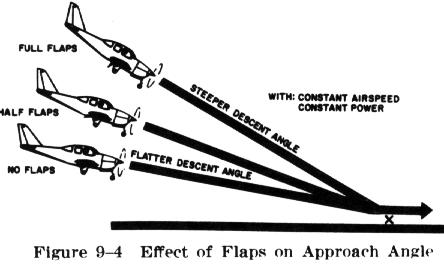
Immediately after the base to final approach turn is completed, the longitudinal axis of the airplane should be aligned with the centerline of the runway or landing surface, so that drift (if any) will be recognized immediately. On a normal approach, with no wind drift, the longitudinal axis should be kept aligned with the runway centerline throughout the approach and landing. (The proper way to correct for a crosswind will be explained under the section "Crosswind Approach and Landing." For now, only an approach and landing where the wind is light or straight down the runway will be discussed.)
After aligning the airplane with the runway centerline, the final flap setting should be completed and the pitch attitude adjusted as required for the desired rate of descent. Slight adjustments in pitch and power may be necessary to maintain the descent attitude and the desired approach airspeed. In the absence of the manufacturer's recommended airspeed, a speed equal to 1.3 Vs0 should be used; that is, if Vs0 is 60 knots, the speed should be 78 knots. When the pitch attitude and airspeed have been stabilized, the airplane should be retrimmed to relieve the pressures being held on the controls.
The descent angle should be controlled throughout the approach
so that the airplane will land in the center of the first third of the
runway. The descent angle is affected by all four fundamental forces that
act on an airplane (lift, drag, and thrust, and weight). If all those forces
are constant, the descent angle will be constant in a no wind condition.
The pilot can control those forces by adjusting: (1) the airspeed, (2)
the attitude, (3) the power, and (4) the drag (flaps or forward slip).
The wind also plays a prominent part in the gliding distance over the ground;
naturally, the pilot has no control over the wind but may correct for its
effect on the airplane's descent by appropriate pitch and power adjustments.
 |
Considering the factors that affect the descent angle on the final approach, for all practical purposes at a given pitch attitude there is only one power setting for one airspeed, one flap setting, and one wind condition. A change in any one of these variables will require an appropriate coordinated change in the other controllable variables. For example, if the pitch attitude is raised too high without an increase of power, the airplane will settle very rapidly and touch down short of the desired spot (Fig. 9-2). For this reason, NEVER TRY TO STRETCH A GLIDE BY APPLYING BACK ELEVATOR PRESSURE ALONE to reach the desired landing spot. This will shorten the gliding distance if power is not added simultaneously. Therefore, the proper angle of descent and airspeed should be maintained by coordinating pitch attitude changes and power changes. |
The objective of a good final approach is to descend at an angle and
airspeed that will permit the airplane to reach the desired touchdown point
at an airspeed which will result in a minimum of floating just before touchdown.
To accomplish this it is essential that both the descent angle and the
airspeed be accurately controlled. Since on a normal approach the power
setting is not fixed as in a power off approach, the power should be adjusted
as necessary to control the airspeed, and the pitch attitude adjusted SIMULTANEOUSLY
to control the descent angle or to attain the desired altitudes along the
approach path. By lowering the nose and reducing power to keep approach
airspeed constant, a descent at a higher rate can be made to correct for
being too high in the approach. This is one reason for performing approaches
with partial power; if the approach is too high, merely lower the nose
and reduce the power. When the approach is too low, add power and raise
the nose. On the other hand, if the approach is extremely high or low,
it is advisable to reject the landing and execute a go-around. This procedure
is explained later in this chapter.
 |
The lift/drag factors may also be varied by the pilot to adjust the descent through the use of the landing flaps (Figs. 9-3, 9-4). When the flaps are lowered, the airspeed will decrease unless the power is increased or the pitch attitude lowered. After starting the final approach, the pilot must then estimate where the airplane will land through discerning judgment of the descent angle. If it appears that the airplane is going to overshoot or land slightly beyond the desired spot, more flaps may be used if not fully extended or the power reduced further, and the pitch attitude lowered. |
 |
This will result in a steeper approach. If the spot is being undershot
and a shallower approach is needed, the power and the pitch attitude should
be increased to readjust the descent angle and the airspeed. NEVER RETRACT
THE FLAPS TO CORRECT FOR UNDERSHOOTING since that will suddenly decrease
the lift and cause the airplane to sink even more rapidly.
Generally, prior to the approach the airplane will have been trimmed to a state of balance and equilibrium in level flight at cruising power and airspeed. However, during the approach to a landing, the power is at a considerably lower than cruise setting and the airplane is flying at a relatively slow airspeed. It becomes apparent, |
It will be found that the roundout, touchdown, and landing roll are much easier to accomplish when they are preceded by a proper final approach with precise control of airspeed, attitude, power, and drag, resulting in a stabilized descent angle.